卸任星巴克CEO之后,舒尔茨还有更重要的事情需要证明
Beth Kowitt | 2017-07-16 21:30
分享:
 [译文]
[译文]
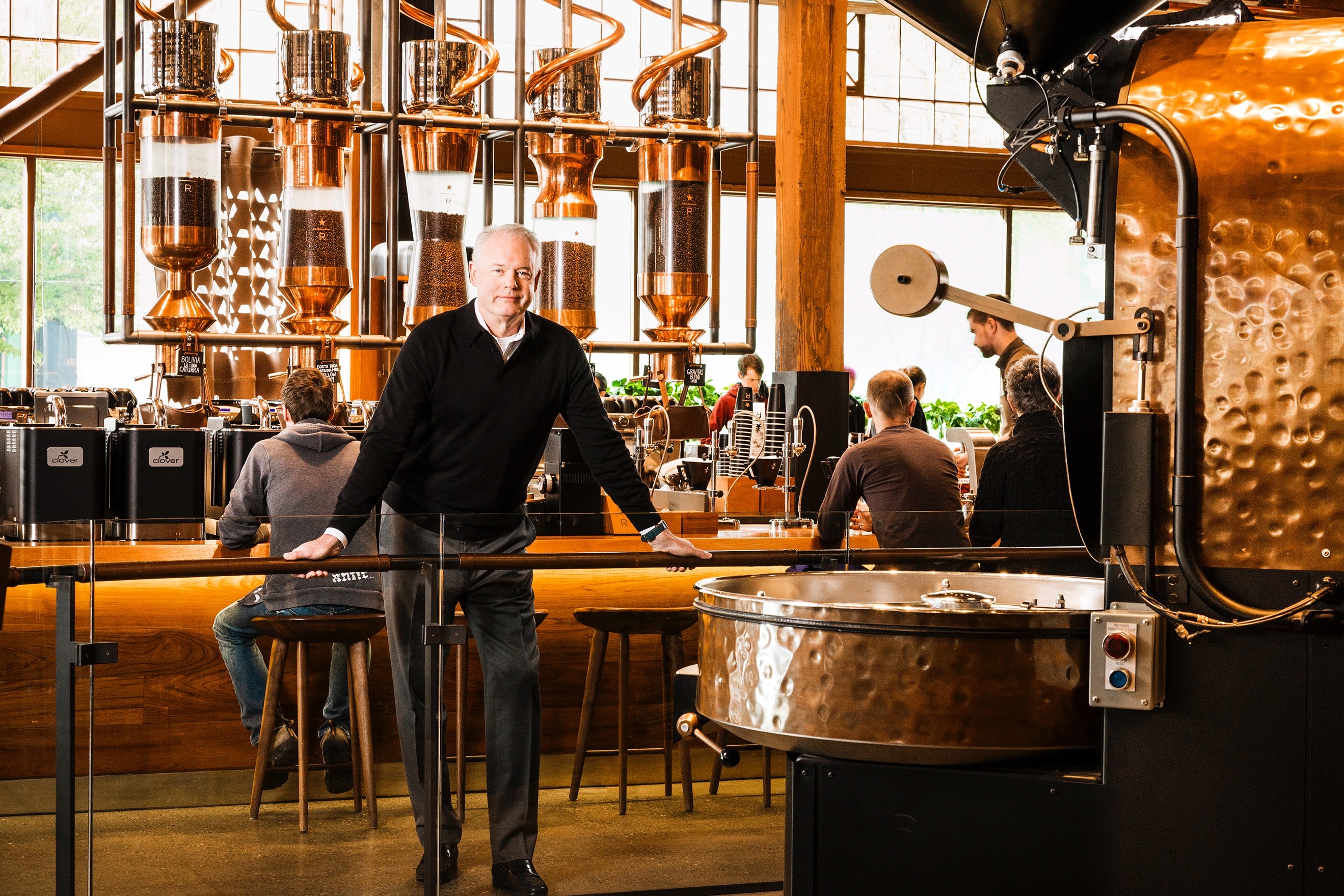
Every year, before Starbucks’ (sbux, -1.07%) annual meeting, Howard Schultz goes to its original store at Seattle’s Pike Place Market to drink a doppio macchiato and reflect on how far the company has come in his more than 30 years there. The most recent annual gathering on March 22 was Schultz’s last during his second run as CEO. That gave the ritual added weight, and he planned a ceremonial moment to mark the occasion.
Schultz was scheduled to arrive at the store at 6:30 a.m., but he’s notorious for running early— “Howard time,” as a colleague calls it. Those playing some part knew to get there by 6:15 or risk missing him completely. One of those people was Kevin Johnson, Schultz’s chosen successor as CEO. That morning the two, both in shirt and tie, suit jackets doffed, spent a few minutes together amid the bags of beans. Schultz reminisced about the early days.
Then he formally presented Johnson with the key to the original store, a possession he said he had carried in his pocket for nearly 35 years. The two posed for a photo and by 6:22, with the sun yet to rise, both were gone. “Note to self: Don’t lose the key,” Johnson stage-whispered on his way out the door.
每年,在星巴克年度会议召开前夕,霍华德·舒尔茨总会去一趟坐落于西雅图派克市场的首家星巴克店面,喝一杯双份玛奇朵,并借机反思这家公司30多年来走过的风雨历程。3月22日召开的年度会议,是舒尔茨第二个CEO任期的最后一次,这个惯例由此增加了额外的分量。他计划搞个仪式来纪念这一时刻。
舒尔茨拟定在上午6点半到达店铺,但他以早起跑步而著称,就像一位同事所言,他遵循的是“霍华德时间”。那些将要在这个仪式上扮演角色的员工知道,他们需要在6点15分之前到达那里,不然就很可能看不到他的人影。其中一位是舒尔茨钦定的CEO接班人凯文·约翰逊。那天早上,两人身着衬衫和领带,在摆放着一袋袋咖啡豆的店铺小聚了几分钟。舒尔茨回忆起这家咖啡店的早期岁月。
然后,他正式向约翰逊递交了这家咖啡店的钥匙。他说,近35年来,他一直随身携带着这把钥匙。两人合影留念。到早上6点22分,太阳还没有升起的时候,两人就离开了。“自我提醒:不要把钥匙弄久了。”在走出店门的时候,约翰逊高声耳语道。
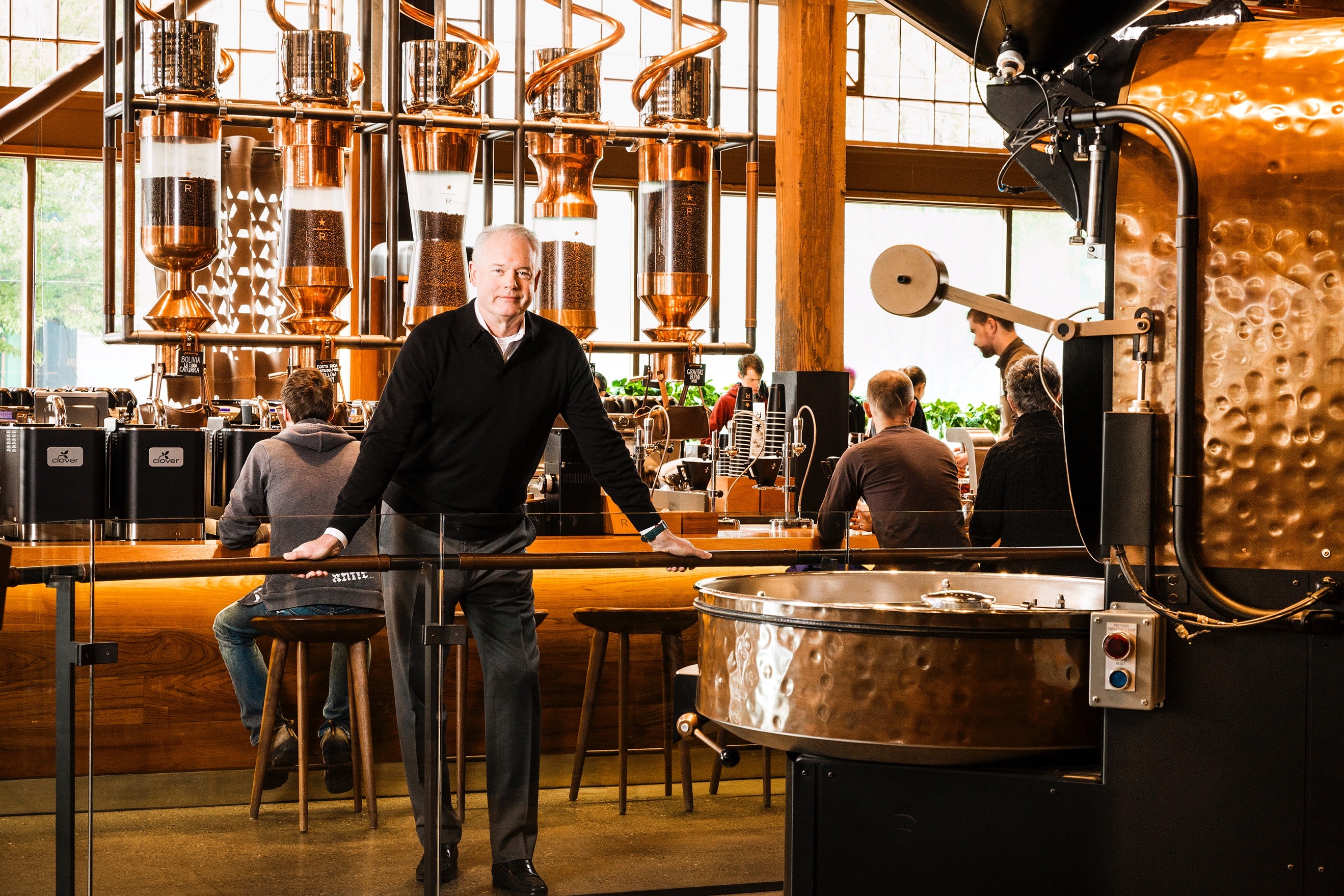
新任CEO约翰逊将依靠他的技术经验,专注于打造星巴克的数字订购业务
图片提供:Brian Smale
The new CEO need not have worried, it turns out. “I have another key,” Schultz tells me a month and a half later in his office at the company’s Seattle headquarters.
Could there be a more apt metaphor? Handing over control of a company is always tricky—Schultz, 63, officially relinquished the CEO job on April 3—and doubly so when it involves a charismatic, longtime leader who all but founded the company.
In Schultz’s case, how does a notorious perfectionist who craves total control apply his perfectionism to the act of ceding control? That challenge is all the more fraught because his most notorious professional failure by far was his last attempt to leave as CEO, in 2000, a slow-boiling disaster that eventually concluded with his triumphant return. Schultz really, really, really wants to nail it this time. “I would say that, of the list of the most important things that a public CEO has to get right, succession is in the top three,” he says. “I did not get it right the first time around.”
For its part, Wall Street has made its position absolutely … contradictory: Starbucks must prepare a new generation of leadership!! And also, Howard, could you stay just a little longer?!?
None of that makes it easy for Johnson, 56. In addition to replacing a legend—as he has quipped, he has venti-sized shoes to fill—the new CEO is doing so at a time when Starbucks’ sales have turned from scalding to tepid. Same-store sales, a key metric, are still rising, but at the slowest pace since the financial crisis. The company has fallen short of analysts’ expectations on that measure for five consecutive quarters.
Despite that, Starbucks’ ambitions are audacious. The company recorded $21.3 billion in revenues last year, ranking it at 131 on the Fortune 500—and it’s projecting it will reach $35 billion in sales by 2021. To achieve that hoped-for 64% revenue explosion, Starbucks plans to open some 12,000 stores over the next five years, which would bring its total count to 37,000. The majority will be in China, a market the company thinks could be its biggest someday. Some 3,400 of the new stores will be in the U.S. (By comparison, Chipotle has about 2,300 in its entire system.)
Beyond covering the planet with coffee bars, Starbucks has two main growth initiatives, which Johnson calls the “most critical things for the future of the company.” Johnson will be in charge of one of them: the continuing development of Starbucks’ digital and mobile operations. That’s a natural mission for him, given that he was an executive at Microsoft (msft, -0.54%) for many years and, later, CEO of telecom hardware maker Juniper Networks. Starbucks is already a leader in this realm, with 25% of orders now placed or paid digitally. Johnson’s task will be to expand and iron out the logistics so that a system made to facilitate speed and convenience doesn’t leave customers frustrated and cooling their heels.
The second key area will fall to Schultz. As executive chairman, he’s leading Starbucks’ push to develop a higher-end brand and “experiential destinations” to entice people who have abandoned malls to stop by a store. That strategy involves a three-pronged attack consisting of (1) the Roastery, a handful of massive, ultraluxurious coffee palaces inspired in part by Charlie and the Chocolate Factory; (2) a new brand of rare and single-origin coffee beans called Reserve; and (3) a second line of boutiques—a notch above a regular Starbucks but not quite as over the top as the Roastery—also called Reserve. If all goes well, those options might even lure some self-styled purists who spend $16 for a cup of single-origin pour-over at an “artisanal” coffee emporium like Blue Bottle and wouldn’t deign to set foot inside a Starbucks.
There’s a tension there. Schultz wants to keep serving 90 million people a day, maintain the admiration of Wall Street—and be respected by the coffee community. He’s an aficionado, and this feels personal. It’s no coincidence that his drink of choice, the double macchiato—a traditional espresso “stained” with a dash of frothy milk—is downed more often by people standing at the bar of a café in Rome than in a typical Starbucks.
But his company achieved epic success not so much by emulating Italian coffee as by adapting it to American tastes, what one tiny rival derides as the “Big Gulp version of coffee and milk.” Schultz initially hesitated to sell frappuccinos, says Howard Behar, a Starbucks executive for 21 years. “It didn’t live up to his purist idea of coffee,” says Behar. Schultz has always asked one question, Behar says, since the beginning: How do we elevate the coffee? Now he’s making it his primary mission. All of which suggests he won’t be leaving anytime soon.
The first time Schultz stepped aside as CEO in 2000, the process started fairly smoothly. His successor, Orin Smith, was a company veteran who had served as CFO and COO at various times. Schultz knew and trusted him. Business was booming.
The circumstances changed five years later, after Smith retired. By then Jim Donald had taken over, and Schultz’s relationship with him became “complicated,” according to Schultz’s 2011 book Onward. Donald, a former Walmart (wmt, +0.48%) executive, was an outsider, and the two regularly disagreed on major hiring decisions. Schultz’s entrepreneur’s disease—his inability to detach from the company he had built—began to show itself. “I put the responsibility on myself,” he tells Fortune. “I don’t think I was prepared as I certainly am today to recognize the need to let go.”
Schultz returned as chief executive in 2008 as the business struggled, owing to a combination of a spiraling economy and what Schultz, in a famous leaked memo to Donald, called the “commoditization of the Starbucks experience.” Schultz, who had retained the chairman title, returned to the CEO job and was hailed for the turnaround and the stellar run that followed.
Those kinds of accolades are great for the ego but less so for succession plans. When Johnson was announced as CEO on Dec. 1, the company’s stock briefly dropped 12% in after-hours trading. “Investors are very focused on it,” says restaurant industry analyst John Zolidis. “They’re well aware of what happened the last time Howard Schultz stepped aside.”
Schultz is now walking a fine line, making it clear that Johnson is running the business but signaling that the big kahuna is never far away. “I say not only that he’s becoming the CEO of Starbucks, but I want you to know he is going to be the CEO,” Schultz said during his prepared remarks at the company’s investor day in December, preempting the likely question from analysts. “He’s got the last word. He is running the company.” All of Schultz’s direct reports except for two—Liz Muller, senior vice president of creative, global design, and innovation, and Cliff Burrows, president of the group overseeing the Roastery and Reserve—have shifted to Johnson.
Still, it takes time for everyone to adjust, and even Schultz’s attempts to be encouraging betrayed the faintest hint of the old lion patronizing his successor. Less than a month after Johnson officially became CEO, he hosted his first earnings call with analysts on April 27, and Schultz was on the line.
“Kevin, congratulations on your first call. I think you did really well,” he said after the presentation of the company’s results, which had failed to meet analysts’ targets. Referring to Starbucks’ China CEO, Belinda Wong, Schultz added, “And, Belinda, coming from China in the middle of the night, I could not be more proud of you.”
Johnson ran the management discussion but left time for Schultz—who described himself as the “unscripted closer to summarize what’s been said”—to speak before executives took questions.
Schultz is adamant that this transition will be different from the last. For one thing, he says, Johnson isn’t an outsider. That’s technically true, but slightly misleading. Johnson, a company director since 2009, spent his career at Microsoft and other tech companies, then took an executive role as Starbucks’ chief operating officer and president in 2015, beginning when the last heir apparent, Troy Alstead, departed.
Some analysts question Johnson’s lack of retail chops, but Schultz has stressed the importance of his experience as a 34-year tech industry veteran. This increasingly critical digital business is not Schultz’s “primary skill,” he admits.
事实证明,这位新CEO根本不用担心。一个半月后,在星巴克西雅图总部办公室,舒尔茨对我说,“我还有一把钥匙。”
还有比这更加贴切的隐喻吗?移交一家公司的控制权,向来都是很棘手的事情,而当这个过程涉及到一位极具魅力,几乎一手创建这家公司的长期领导者时,其难度无疑会翻番。4月3日,63岁的舒尔茨正式卸任星巴克CEO一职。
就舒尔茨的例子而言,一个不可避免的问题是,一位以渴望获得绝对控制权著称的完美主义者,将如何把他的完美主义应用到控制权的让渡上?考虑到他迄今为止最著名的职业失败正是他上一次卸任CEO的尝试——这起发生在2000年的卸任事件,逐渐演化为一场缓慢沸腾的灾难,最终以他的胜利回归收场——这项挑战显得愈发严峻。舒尔茨真的极其渴望这一次能顺利搞定。“我觉得,在一位上市公司CEO必须做好的重大事务清单上,接班人议题绝对排在前三项。我第一次搞砸了。”他说。
对于舒尔茨卸任CEO,华尔街已经表达了极其矛盾的立场:星巴克必须准备迎接新一代的领导层!霍华德,你能否继续坚守一段时间呢?
对于56岁的约翰逊而言,所有这些观点都不会让他感到轻松。除了接替一位商界传奇人物之外,这位新CEO的履新时间正值星巴克的销售额从“滚烫”转入“微温”之际。作为一项关键指标,同店销售额仍然在上涨,但其增长步伐正处于金融危机以来最慢的时刻。这家公司已经连续五个季度未能实现分析师对该指标的预期值。
尽管如此,星巴克仍然雄心不减。凭借去年创造的213亿美元收入,该公司在《财富》500强榜单中排名第131位。根据星巴克自己的预计,到2021年,其营收将增至350亿美元——也就是说,该公司的营收将爆炸式增长64%。为实现这一雄心勃勃的目标,星巴克计划在未来五年开设约1.2万家门店,门店总数将达到3.5万家。大多数新店将开设在中国。星巴克认为,有朝一日,中国将成为其最大的市场。其中约3400家店面将开设在美国本土。(相比之下,专注于墨西哥菜品的Chipotle快餐店只有大约2300家店面。)
除了用咖啡店覆盖这个星球之外,星巴克还有两大增长计划。按照约翰逊的说法,这是两件“对该公司未来至关重要的大事”。约翰逊将负责其中之一:持续推动星巴克的数字和移动业务。鉴于他曾经在微软担任多年高管职位,后来又出任电信硬件制造商Juniper Networks公司首席执行官,对于他来说,这是一项自然而然的使命。在这一领域,星巴克已然扮演领导者的角色,其25%的订单现在采用数字方式订购或支付。约翰逊的任务是扩大和烫平物流环节,以创建一个旨在促进速度和便利性,不会让客户感到沮丧和长时间等待的系统。
第二个关键领域将由舒尔茨亲自挂帅。作为执行董事长,他正在引领星巴克开发一个高端品牌和“体验式目的地”,以吸引那些放弃购物中心,转而光临小店的消费者。这项策略涉及一波三管齐下的攻势,其中包括(1) Roastery咖啡烘焙工坊——这是星巴克受电影《查理和巧克力工厂》启发而建立的少数几家大型超豪华咖啡宫殿;(2)一种被称为Reserve甄选的稀有咖啡豆,这是一个全新品牌;(3) Reserve甄选咖啡门店,属于二级精品店,比一般的星巴克咖啡店高一级,但没有Roastery咖啡烘焙工坊那样高端。如果一切顺利,这些新选项甚至有可能吸引一些以纯正咖啡主义者自诩的消费者。这些消费者宁愿花费16美元,在诸如Blue Bottle这类“手工作坊”购买一杯单一产地咖啡,也不愿屈尊光临星巴克。
此处蕴含着潜在的冲突。舒尔茨希望继续服务于每天光临星巴克咖啡店的9000万消费者,维系华尔街对该公司的推崇,并获得咖啡界的尊重。他是一位狂热的咖啡爱好者,这是一种非常个人化的感觉。绝非巧合的是,他喜欢喝双份玛奇朵,这种被浓郁的牛奶泡沫“染色”的传统浓咖啡,往往是那些步入罗马咖啡馆(而不是一家典型的星巴克咖啡店)的消费者的首选。
但他的公司之所以获得史无前例的成功,并不是得益于仿制意大利咖啡,而是因为它完美地适应了美国人的口味。正如一位小型竞争对手嘲笑的那样,星巴克咖啡是“咖啡和牛奶的‘大口吞饮’版本”。在星巴克服役21年的资深高管霍华德·贝哈尔透露称,舒尔茨最初不太愿意销售星冰乐。“它不符合他对纯咖啡的理解,”贝哈尔说。从一开始,舒尔茨总是询问一个问题:我们如何提升咖啡的品质?现如今,他正在将其作为自己的首要任务。所有这些都表明,他不会马上离开。
首次卸任失败
2000年,舒尔茨首次卸任CEO。这个进程起初相当顺利。他的继任者奥林·史密斯是星巴克的老臣子,曾在不同时期担任首席财务官和首席运营官。舒尔茨对他颇为了解,信任有加。公司业务蓬勃发展。
五年后,在史密斯退休之后,情况发生了变化。到那时,吉姆·唐纳德已经接管最高权杖。舒尔茨在2011年出版的著作《一路向前》中透露称,他与这位CEO的关系变得非常“复杂”。作为一位前沃尔玛高管,唐纳德是一位局外人,两人经常在一些重要的招聘决策上产生分歧。舒尔茨身上的“企业家病”——他无法脱离他所建立的公司——开始显露出来。他告诉《财富》杂志,“我把责任放在了自己的肩头。我不认为我当时像今天这样认识到了放手的必要性。”
2008年,舒尔茨重返首席执行官岗位。彼时,星巴克的业绩正陷于挣扎,美国经济急转直下固然是一个因素,但正如舒尔茨在一封泄露的致唐纳德备忘录中所言,另一个重要原因是“星巴克体验的商品化”。在回归最高职位之后,此前留任董事会主席一职的舒尔茨带领这家咖啡连锁巨头摆脱颓势,并迎来了一段黄金发展期。舒尔茨本人也由此赢得广泛声誉。
这些荣誉当然有助于提升舒尔茨本人的自我价值感,但不太利于星巴克的继任计划。去年12月1日,当约翰逊宣布出任CEO时,该公司的股票在盘后交易中短暂下跌12%。餐饮行业分析师约翰·佐利迪斯表示,“投资者非常关注此事。他们非常了解霍华德·舒尔茨上一次卸任时发生的事情。”
舒尔茨现在采用了一种折衷的方式。他清楚无误地表明,约翰逊正在执掌公司,但同时暗示,真正的老大绝不会远离。“我要说的是,他正在成为星巴克的首席执行官,但我希望你知道他将成为首席执行官。”在去年12月份的投资日会议上,舒尔茨在一段事先准备好的发言中这样说道。“他拥有最终决策权。他正在运营这家公司。”除两位高管职位之外,即创意、全球设计与创新高级副总裁丽兹·穆勒,以及Roastery和Reserve事业部总裁克里夫·布罗斯,舒尔茨的所有直接下属都已经开始向约翰逊汇报工作。
不过,每个人都需要调整的时间,就连舒尔茨的一些旨在鼓励的尝试,也难免让人觉得老狮子正在庇护他的继任者。4月27日,在约翰逊正式成为首席执行官不到一个月之后,他主持召开了他上任后首场分析师电话会议,舒尔茨也在线上。
“凯文,祝贺你的首次电话会议顺利召开。我认为你做得很棒。”在约翰逊完成业绩陈述之后,舒尔茨这样说道。(星巴克的业绩未能达到分析师的目标值。)他还对星巴克中国首席执行官王静瑛说,“你在中国半夜参加会议,我真的为你感到骄傲。”
约翰逊主持管理层讨论环节,但在高管们回答问题之前,他留了一段时间让舒尔茨发言。后者表示,他的发言“没有稿子,更加接近于总结陈词。”
舒尔茨坚持认为,这次领导层变更与上一次迥然不同。一方面,他说,约翰逊不是局外人。在技术上,这样说没错,但还是有一定的误导性。约翰逊自2009年起担任星巴克董事。他此前的职业生涯基本上都是在微软等科技公司度过的,随后于2015年,也就是舒尔茨的上一位当然继任者特罗伊·阿尔斯特德离职之后,开始出任星巴克首席运营官兼总裁。
一些分析师质疑约翰逊缺乏零售经验,但舒尔茨着重强调了他长达34年技术从业经验的重要性。他承认,日益关键的数字业务并不是自己的“主要技能”。
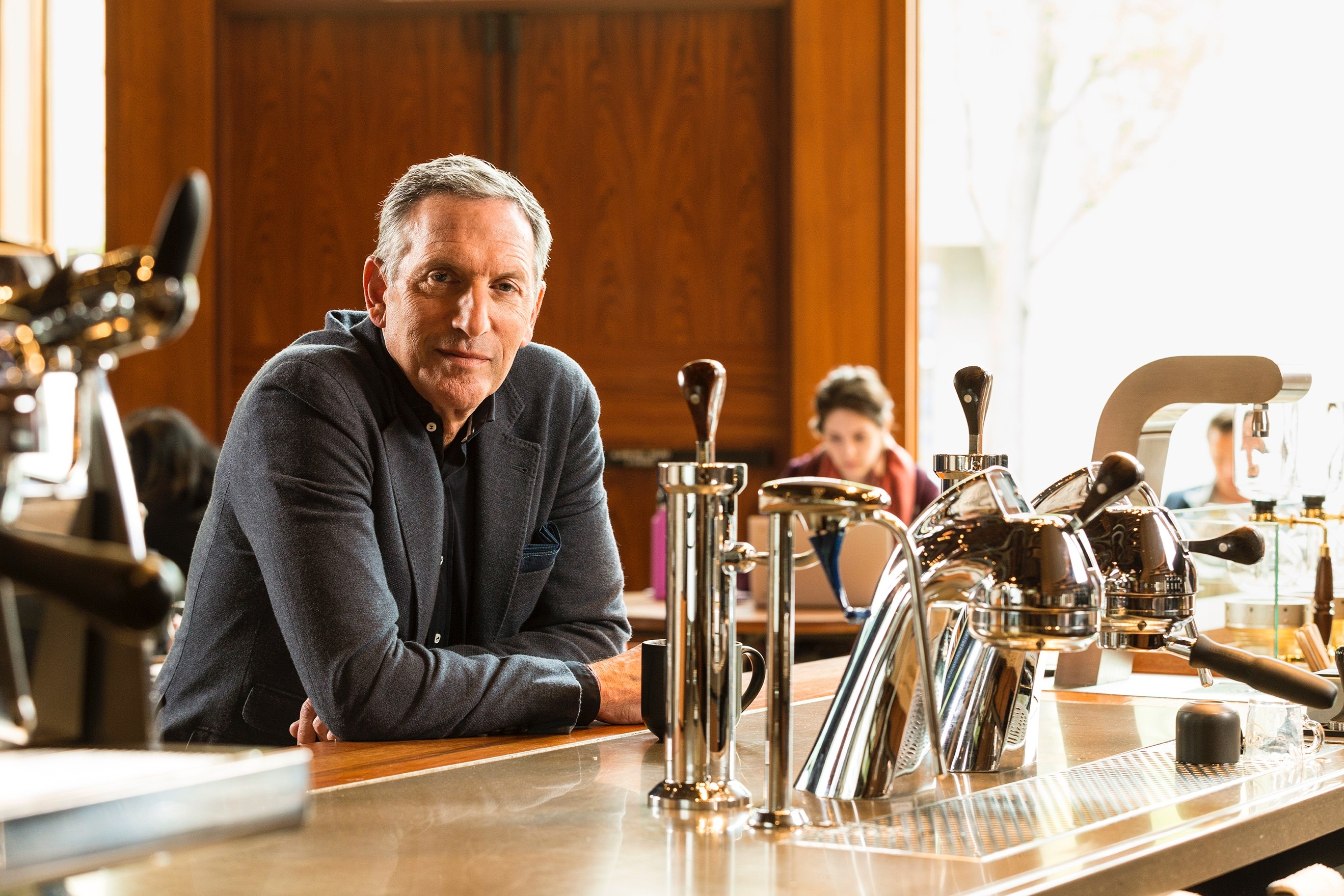
霍华德·舒尔茨在西雅图Roastery咖啡烘焙工坊
图片提供:Brian Smale
Schultz also had started to see not only the potential and importance of the Roastery and Reserve brands but the time investment they would require. “My schedule was not going to be compatible with running the company day to day,” he says. “And I had my own private moment of realizing I honestly believe that Kevin would be better suited to run the future of Starbucks than myself.”
Compared with Schultz, a double macchiato of an executive—he’s intense and caffeinated—Johnson comes across as a decaf vanilla latte. (He says he favors a triple macchiato.) Johnson is methodical in his responses—he’s data-driven, whereas Schultz tends to operate more on instinct—and hews to a standard CEO script. When I interviewed the duo together in Schultz’s office in May, Johnson gave a careful minute-and-a-half analysis of their differing leadership styles before Schultz jumped in. “Kevin is calmer, more patient,” Schultz says. “I was born restless.”
One of countless examples: Starbucks’ SVP Muller was on a trip to China when Schultz wanted her to fly back right away to look at the site he had found for the Seattle Roastery. He then called her while she was on vacation in South Africa to tell her they should open more.
Starbucks had perhaps gotten too big for Schultz to run alone, given his exacting attention to detail. Years ago he became obsessed with the company’s breakfast sandwiches because he thought the odor of burning cheese—in particular cheddar—overwhelmed the coffee aromas in the store. While Donald was CEO, Schultz pushed unsuccessfully to remove all breakfast sandwiches from the menu. Then, when he returned as CEO, he again took up the issue, ultimately instituting a series of new procedures (including placing the cheese in a different part of the sandwich) to avoid burning it.
“If you’re a control freak and there’s 20,000 stores waiting for you to tell them what to do, it’s not going to work,” says Dave Olsen, a senior adviser to Starbucks. He recalls that in the days before speed dial, Schultz had some 50 to 70 store phone numbers memorized. “His passion, his intense drive, all of that could play out in that way when there were that many stores.”
Schultz’s quest for perfection, which may have been part of the problem during the last CEO handoff, just might help the transition this time around. One failed changeover could be chalked up to a fluke; two makes it look like Schultz’s problem. That’s not a mark that he wants on his record.
In 2009, as Starbucks’ turnaround was underway, Schultz jotted a few phrases on a Post-it: “the Willy Wonka of coffee,” “take customers on a magical carpet ride,” “totally immersive joyful customer experience,” “coffee at its peak.” Schultz let the idea percolate until 2012, when he found what he believed to be the perfect laboratory: a 15,000-square-foot onetime Volvo dealership on Pike Street in Seattle. Schultz had Muller, the company’s head of creative and design, come over to his house to watch Charlie and the Chocolate Factory with him.
Starbucks opened the Roastery, its “coffee shrine,” in December 2014, and indeed it has some “chocolate factory” touches, albeit in a much more elegant setting. Tubes shoot coffee beans through stages of the roasting process before they land at the coffee bar. There you can order a micro-lot like Cape Verde Fogo Island or Rwanda Maraba, brewed using methods not available in a typical Starbucks: Chemex, pour-over, a high-tech Clover brewer, French press, siphon, or manual espresso (the regular stores use automatic machines). The Roastery is filled with copper and hand-stained, reclaimed wood.
The retail section sells items like thermoses that set your coffee to a selected temperature for $149.95, or a Miir McCall Cruiser bike designed exclusively for the Roastery, complete with a carrier for your cold-brew growler, for $1,499.95. Customers have spent accordingly. The average visitor spends about $20 at the Roastery, about four times the outlay at the typical Starbucks.
The Roastery achieves something that few regular Starbucks can accomplish: It attracts significant clientele during the afternoon and evening. At the Roastery, the majority of sales occur in the afternoon. (The company has tried in the past to boost later-day sales at regular Starbucks, by selling wine and beer at 400 locations as part of its “Evenings” program, which was supposed to launch in thousands of stores over time. The company says it “paused” the endeavor in many stores in January.)
The company plans to open 20 to 30 Roastery locations, with projects underway in New York, Chicago, Tokyo, and Shanghai. These sites will roast coffee for Starbucks’ premium Reserve brand, which will also be served in 1,000 Reserve stores—essentially mini-Roasteries that are twice the size of a typical Starbucks. The first will open inside the company’s headquarters in the fall, with the second planned for Chicago in 2018. Reserve stores are expected to generate $3 million in annual sales, twice that of the typical Starbucks. Eventually 20% of Starbucks will have a high-end Reserve bar. The company is also upping its food game for the Roastery and Reserve cafés with its investment in Italian luxury baker Princi.
此外,舒尔茨不仅发现了Roastery和Reserve品牌的潜力和重要性,也逐渐意识到了它们所需要的时间投资。“我的日程安排将与公司的日常运营事务严重冲突。”他这样说道。“在私下里,我真心相信凯文比我自己更加适合运营星巴克的未来。”
如果说舒尔茨就像是高管中的“双份玛奇朵”,激情四射,活力十足,那么约翰逊就是一杯“无咖啡因的香草拿铁”。回应《财富》的问题时,约翰逊显得非常有条理——他是数字驱动型高管,而舒尔茨则更加倾向于根据本能运营企业——恪守标准的CEO脚本。5月份,当我在舒尔茨的办公室同时采访他们两人时,约翰逊花了一分半钟仔细分析两人不同的领导风格,舒尔茨随后插话说,“凯文更安静,更耐心,我生来就不安分。”
这方面的例子不胜枚举。比如,当星巴克高级副总裁穆勒正在中国出差时,舒尔茨突然要求她即刻飞回美国,查看他此前为Roastery咖啡烘焙工坊选择的店址。随后,当穆勒在南非度假时,舒尔茨给她打电话说,他们应该开设更多的烘焙工坊。
鉴于舒尔茨对细节极端苛求的关注,他或许无法独自执掌一个庞大如星巴克的商业帝国。几年前,他开始痴迷于公司的早餐三明治,因为他认为燃烧奶酪(特别是切达干酪)的气味淹没了门店里的咖啡香气。由于当时的CEO是唐纳德,舒尔茨未能成功地将所有的早餐三明治从菜单中删掉。后来,当他重新出任CEO的时候,他再次着手解决这个问题,最终制定了一系列新程序(包括将奶酪放在三明治的不同部分)以避免燃烧气味。
星巴克高级顾问戴夫•奥尔森表示:“如果你是一个控制狂,有两万家店面等着你告诉他们该怎么做,那根本就是行不通的。”他回忆说,在快速拨号时代之前的那些日子,舒尔茨竟然将大约50到70家店面的电话号码烂熟于心。“当星巴克只有那么多店面时,他的激情和干劲可以以那样一种方式展示出来。”
舒尔茨对完美的不懈追求,或许在一定程度上导致他上一次未能完美卸任CEO。但这一次,这种追求或许有助于最高权杖的顺利过渡。一次失败的换班或许可归咎于意外;两次失败则会让人觉得这是舒尔茨自己的问题。他绝对不希望自己的职业生涯留下这样一个难以抹去的污点。
Roastery烘焙工坊
2009年,随着星巴克开始重新走上正轨,舒尔茨在一张便利贴上写下了几个短语:“威利·旺卡咖啡店,”“带顾客踏上神奇的地毯,”“完全沉浸于快乐的客户体验,”“咖啡巅峰。”舒尔茨让这个想法不断扩散,直到2012年,他发现了一个他认为堪称完美的实验室:一个坐落于西雅图派克街,面积达1.5万平方英尺的前沃尔沃汽车经销店。舒尔茨邀请该公司创意和设计主管穆勒来他家,和他一起观看电影《查理和巧克力工厂》。
2014年12月,星巴克的首家Roastery烘焙工坊——该公司的“咖啡神社”——正式起航。实际上,这家店面确实有一些“巧克力工厂”元素,尽管它身处一个非常优雅的环境之中。咖啡豆经管道穿过烘焙过程的各个阶段,最后降落在咖啡吧。在那里,你可以点一杯微批次咖啡,比如佛得角福戈岛或卢旺达马拉巴。这类咖啡采用不同于普通星巴克店面的酿造方法:锥形咖啡壶、手冲、Clover咖啡机、法压壶、虹吸式咖啡壶或者手工浓缩壶(普通店面使用自动机器)。Roastery烘焙工坊充满了铜和手工染色的再生木材。
在零售区以149.95美元价格销售的热水瓶,可以将你的咖啡设定在一个选定的温度,还有专为Roastery烘焙工坊设计的Miir McCall Cruiser自行车,配有一个可承载Cold Brew冷萃咖啡壶的货架,售价1499.95美元。这些产品深受客户欢迎。在Roastery烘焙工坊,访客平均花费约20美元,是普通星巴克店面的4倍左右。
Roastery烘焙工坊实现了普通星巴克店面难以完成的事情:它吸引大批客户在下午和晚间光临店面。在Roastery,大部分销售发生在下午。(该公司曾经尝试在400个店面销售葡萄酒和啤酒,以推动普通星巴克店面的午后销售额。星巴克原计划在数千家门店推出这项名为“Evenings”的计划。今年1月份,该公司发布声明称“暂停”了这种尝试。)
这家公司计划开设20家至30家Roastery烘焙工坊,在纽约、芝加哥、东京和上海的开店计划已经启动。这些店面将烘焙星巴克高端品牌Reserve咖啡。1000家Reserve门店也将提供Reserve咖啡。这些门店堪称迷你型Roastery烘焙工坊,其规模是普通门店的两倍。首家门店将于今年秋天在该公司总部开门营业,第二家将于2018年落户芝加哥。Reserve门店预计将产生300万美元的年销售额,是普通星巴克门店的两倍。最终,20%的星巴克店面将设置一个高端Reserve 咖啡吧。此外,这家公司还引入意大利手工烘焙和美食品牌Princi,为Roastery烘焙工坊和Reserve门店提供独家食品供应。
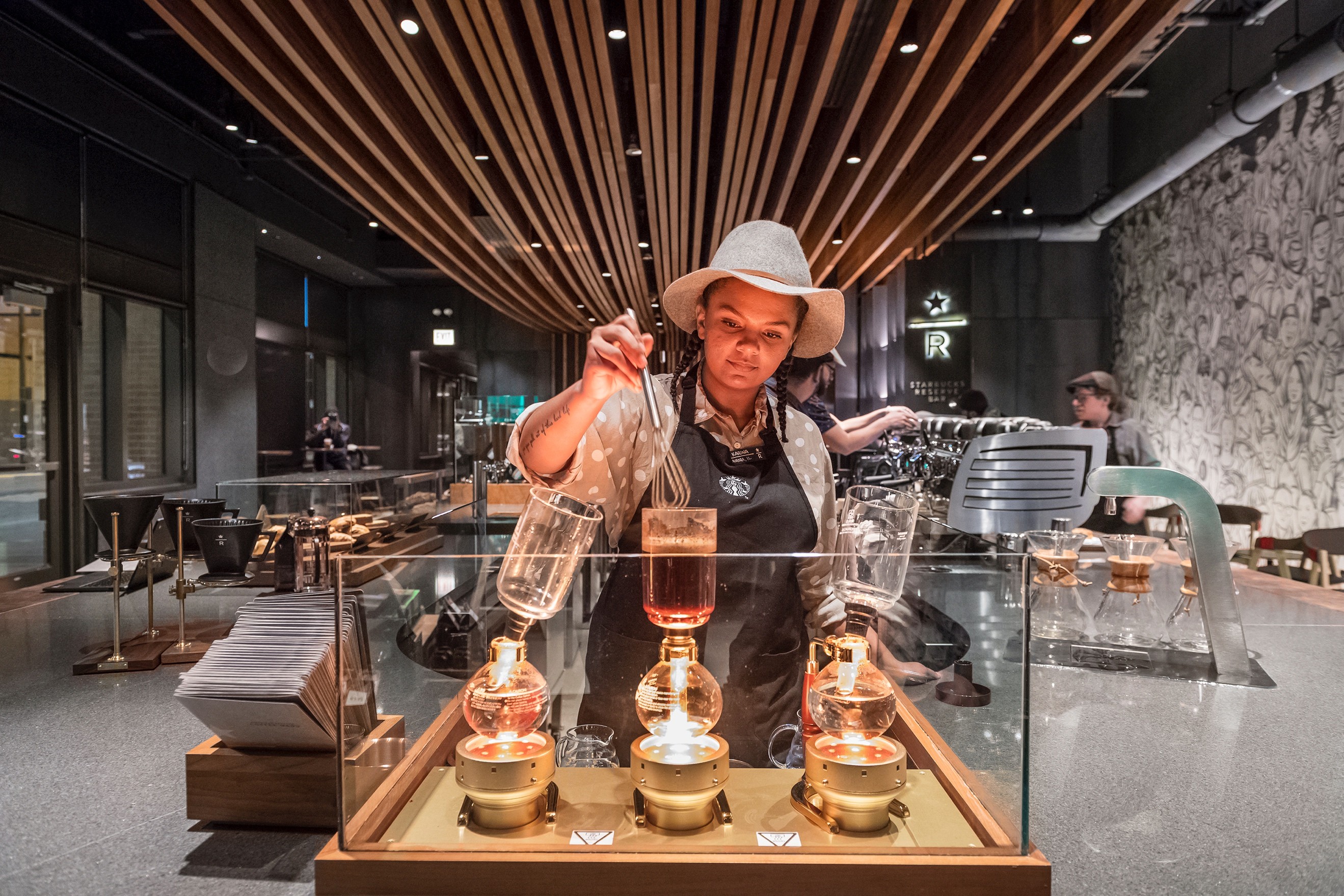
在一家设有Reserve咖啡吧的星巴克,一位员工使用虹吸式咖啡壶酿制咖啡
图片提供:Courtesy of Starbucks
These projects are designed to engage the customer: a tasting menu of coffee flights or the glow of the bright bulb under the siphon brewer. The company realizes it no longer can count on malls to attract shoppers who then wander into Starbucks. With millions of customers abandoning in-person shopping and flocking online, Starbucks needs to draw them on its own.
The Roastery and Reserve initiatives are also an attempt to head off rising competition from high-end coffee shops. Says Tim Calkins, a professor of marketing at Northwestern’s Kellogg School of Management: “Starbucks is going to have to figure out how you navigate a market that seems to be becoming a little bit more like beer—small crafty players merging and becoming a big force.”
There were many decades when restaurant coffee in the U.S. was almost universally watery and brackish. So when Starbucks stormed the nation beginning in the 1990s with its richer, darker roasts and its lattes, it was a coffee revolution. The offerings were exotic enough that when the New York Times reported on the company’s East Coast expansion in 1993 it felt the need to explain how to pronounce the word “latte.” (LAH-tay, for the record.) Before long, Starbucks was a global behemoth, with mass-scale products that earned it comparisons to McDonald’s in some quarters.
What’s known as the “Third Wave” of small coffee purveyors then emerged in recent years as a rejection of Starbucks and an embrace of the broader food movement that reveres ideals like purity, authenticity, and a know-your-farmer philosophy. If Starbucks is where you go for a Pumpkin Spice Latte, the Third Wave shops are where you go to get your single-origin brew (black, please, no sugar) from a specific region.
These newer and cooler chains like Stumptown and Blue Bottle may not be big enough to take market share, though some of them are consolidating and gaining substantial backing. Investment fund JAB Holding, for example, has rolled up a number of coffee companies, including Peet’s, which in turn has purchased Stumptown Coffee and a stake in Intelligentsia.
这些项目旨在吸引客户:一趟咖啡航班的试味套餐,或者虹吸式咖啡壶下的灯泡闪烁的光芒。该公司意识到它无法继续依赖购物中心来吸引消费者漫步到星巴克。随着数以百万的客户放弃亲身购物,涌向在线商场,星巴克需要依靠自身力量来吸引他们。
Roastery 和Reserve计划,也是星巴克为抵挡高端咖啡店日益激烈的竞争压力而做出的尝试。西北大学凯洛格管理学院营销教授蒂姆•卡尔金斯表示:“星巴克不得不设法应对一个似乎变得更像啤酒的咖啡市场。在啤酒市场,小型精酿啤酒商纷纷合并,正在成为一股强大的力量。”
第三波浪潮
在长达数十年的时间里,美国的餐厅咖啡几乎普遍含水,微咸。所以当星巴克从20世纪90年代开始,以更浓郁、更深暗的烘焙和拿铁咖啡冲击整个国家时,那俨然是一场咖啡革命。这些产品带有浓厚的异国情调,1993年报道星巴克在东海岸的扩张时,《纽约时报》甚至觉得有必要解释“拿铁”一词的发音。不久以后,星巴克就成长为一个触角遍及全球的怪兽。许多人认为,在某些方面,这种大规模推出的产品与麦当劳颇为相似。
近年来,被称为“第三波浪潮”的小咖啡供应商迅速崛起,这是一场排斥星巴克,拥抱更广泛食品类别的运动,推崇纯洁、真实性等理念,以及“了解你的农户”哲学。如果星巴克是你喝南瓜香料拿铁的地方,那么“第三波浪潮”就是你品尝单品咖啡的地方。(黑咖啡,不加糖,谢谢。)
像Stumptown和Blue Bottle这类更新、更酷的连锁店,目前或许不足以抢占市场份额,但其中一些正在合并,并且获得了显著的资金支持。比如,投资基金JAB控股公司已经收购了包括Peet’s在内的多家咖啡公司,Peet’s反过来又收购了Stumptown咖啡,并购买了Intelligentsia的股份。
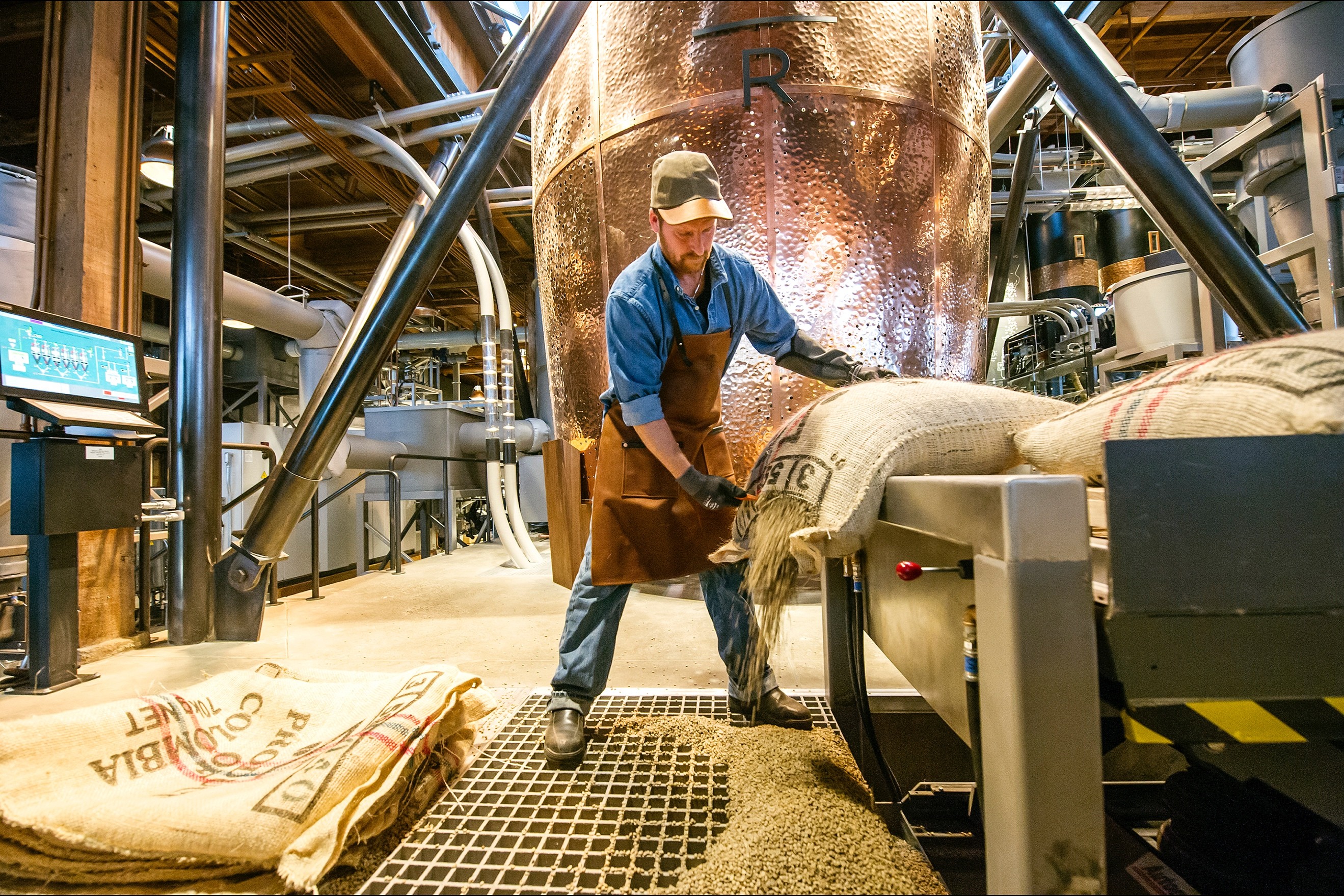
一名工人在Roastery烘焙工坊的预备区倒咖啡豆。这些咖啡豆将经过管道涌入烘焙机,然后在后面的铜桶中冷却
图片提供:Courtesy of Starbucks
But already, these smaller fry are moving consumers’ tastes and habits more upscale in the way Starbucks once did. For the first time in the history of its survey, the National Coffee Association found that more than half of the coffee consumers reported drinking in the past day was classified as gourmet.
So far, that’s not a real problem for Starbucks, which is included in the gourmet category, because there’s been enough growth to go around. But increasingly, dynamism is coming from offerings like cold-brew coffee and nitro (coffee infused with nitrogen), both of which have been popularized by the younger, small-batch operations. Starbucks has been forced to try to catch up. (One potential benefit of the Roastery: The shops are less regimented and can experiment. When the company realized it was serving 100 cups of nitro in the Roastery every day, it decided to roll the drink out to regular Starbucks.) “It’s at risk of losing the credentials of very premium coffee,” says Calkins. “Some would say it’s already lost a lot of its credentials.”
One indication that times have changed: The small shops fear Starbucks less than they once did. A decade or so ago they wouldn’t have dreamed of opening near a Starbucks, several independent founders told me. Now they believe they’re no longer competing for the same clientele.
Starbucks keeps a keen eye on the newbies. Todd Carmichael, a founder of La Colombe Coffee Roasters, says members of Starbucks’ R&D team have ordered cases of its canned draft latte. Starbucks even opened its own “stealth” Third Wave shops in Seattle. At its Roy Street store you can order a lavender cortado from a barista who’s wearing flannel rather than a green apron. The company has conducted research on “credibility cues”—a bit like taking a class on authenticity—and discovered that baristas with tattoos are thought to make better coffee.
And thus the Roastery, as appealing as it is, seems like a defensive move, one that is producing derision among the Third Wavers. “They looked at what every high-end coffee bar is doing and checked all the boxes,” says Tony Konecny, a longtime coffee guy who’s now running the coffee program at startup chain Locol. “The impression that I get is that it’s important for Howard to feel like they weren’t losing the high ground with all this revolution that’s happening in high-end coffee bars.”
Still, the force of Howard Schultz’s will should not be underestimated. Bryant Simon, a Temple University history professor who wrote a 2009 book called Everything but the Coffee: Learning About America From Starbucks, says Schultz’s resolve is one reason the company has been so successful. He is unwilling to believe that the company is no longer cutting-edge. Simon says Schultz was apoplectic when people compared Starbucks to McDonald’s. “That’s what keeps them from falling below the middle,” he says. “His own aspirational vision for the brand is enough to keep them there.” The Roastery and the Reserve brand, Simon thinks, “will satisfy in some ways for Schultz a yearning for doing something new and reinvigorating its legitimacy. Then someone in operations will come up with a new Unicorn”—the viral, color-changing neon frappuccino, which the company offered for a week in April. Smith calls this tension a “perfect Starbucks moment.” As he puts it, “It’s a battle that’s been going on at Starbucks for 15 years.”
When Johnson and Schultz are asked about it, Johnson responds by describing Starbucks’ core business as delivering a warm, welcoming experience that’s about coffee and people. The conversation moves on, but a few minutes later Schultz interjects and wants to go back to that point. “The Unicorn frappuccino was a phenomenon in the lexicon of Starbucks,” he says. “What we knew going in was that if we created a product that had the viral nature of being Instagrammable, that it would be accretive to the brand even though it was highly indulgent.” He goes on: “It was catalytic and accretive to the joyfulness of making people smile. And how could that be a bad thing? I think the long answer is that metaphorically, if we’re going to do things like that, we also have to make deposits in reaffirming our leadership position in all things that are in the essence of coffee. The discipline of that is in the art of the possible and the power of ‘and.’ And we’ve been good at that for a long time.”
Milan, the financial and design hub of Italy, plays a central role in the Starbucks creation story. Schultz was working as head of marketing for the company in 1983 when he traveled to Italy for a trade show and discovered the city’s espresso bars. The concept—a place where coffee was the main event—barely existed at the time in the U.S. Starbucks, with its four stores, was primarily a coffee roaster. Schultz went home and pitched to his bosses the idea of re-creating the company in the image of the Milanese coffee bars. They didn’t bite, so Schultz left to start his own—Il Giornale, named after Milan’s daily newspaper. When Starbucks went on the market in 1987, Schultz pulled together $3.8 million from investors and bought it.
Bringing Italian coffee culture to the U.S. was not enough for Schultz; he always dreamed of bringing Starbucks to Italy. As early as 1998 he had it in his sights, telling The New Yorker that to open in the country would be “to climb Mount Everest.” At the time he said it would be at least a year before he made his move. In the end it was closer to 20. The company announced in February that its first location in Italy will be a Roastery in Milan’s old central post office building. It’s scheduled to open in 2018, to be followed by regular Starbucks branches.
Starbucks has conquered most of Europe, but the delay in entering Italy is partly a reaction to the country’s unique coffee culture. Italians drink most of their coffee in the form of espresso—a quick shot that just coats the mouth—while standing at the bar in one of the country’s 150,000 cafés. Andrea Illy, president of the Italian company that bears his family’s name, says that in Italy coffee is consumed as a tiny concentrate, not a hot beverage. “It’s something you drink for physiological properties,” he says. “It doesn’t feed you. It’s an elixir.”
If you want to give yourself away as a tourist, order a cappuccino in the afternoon. “You’re not supposed to drink milk after lunch,” says Paola Bay, a fashion industry veteran who is advising Starbucks on the Roastery here. “That would be madness.”
Bay, a Milan native who now lives in London, takes me to a few of the city’s coffee bars, including Marchesi and Cova. As a sign of how important they are culturally, the Prada Group and LVMH recently invested in the brands. Bay thinks Starbucks will do well in Milan, that the Milanese will order frappuccinos and other novelties exported from the U.S. that they can’t get at an Italian coffee bar.
This is the strange full circle of Starbucks opening in Italy: The company found inspiration in Milan, Americanized it, and is now bringing its Americanized version back to the city. Schultz had “a deep passion for that intimate Italian coffee shop, that authentic experience,” says Christine Day, an early company executive who stayed for two decades, “but the challenge of growth led the company to become known for the innovation of new products, not the Italian coffee shop.” In short, if it were possible to memorialize a person with an eternal cup of coffee on his tombstone, Schultz would no doubt request a macchiato. But history will likely assign him a frappuccino.
A version of this article appears in the June 15, 2017 issue of Fortune. We’ve included affiliate links in this article. Click here to learn what those are.
但是,这些“小鱼小虾”正在像昔日的星巴克那样,推动消费者的口味和习惯更加高档化。全美咖啡协会在其调查中首次发现,超过一半的咖啡消费者将前一天喝的咖啡列为美食。
到目前为止,对于被纳入美食类别的星巴克来说,这还不是真正的问题,因为它已经经历了足够的增长。但活力越来越多地来自冷萃咖啡和氮气咖啡(一种被注入氮气的咖啡)。这两种咖啡一直受惠于年轻的小批量生产商的推广。星巴克被迫扮演追赶者的角色。(Roastery烘焙工坊的一大潜在好处是:店面较少,可以进行实验,当该公司意识到Roastery烘焙工坊每天能够售出100杯氮气咖啡时,它决定将这种饮品推广至普通的星巴克门店。)卡尔金斯教授表示,“星巴克面临失去高端咖啡美誉之风险。有人会说,它已经失去了。”
一个迹象表明时代已经改变:小店面不再像过去那样害怕星巴克。几位独立创始人告诉我,大约10年前,他们不敢梦想在一家星巴克附近开店。现在,他们相信,他们和星巴克不再是同一个客户的竞争对手。
星巴克热切地关注市场新人。白鸽咖啡烘焙店创始人托德·卡迈克尔表示,星巴克研发团队成员已经订购了其瓶装拿铁咖啡。星巴克甚至在西雅图开设了自己的“隐形”第三波浪潮店面。在罗伊街的店面,你可以从一位穿着法兰绒衣服(而不是绿色围裙)的咖啡师那里点一杯薰衣草咖啡。该公司还对“信誉提示”进行了一番研究,发现有纹身的咖啡师被认为会制作更好的咖啡。
因此,尽管它似乎极具吸引力,但Roastery烘焙工坊似乎是一种防御措施,此举正招致第三波浪潮咖啡店的嘲讽。“他们仔细端详每一家高端咖啡吧正在做的事情,然后逐一模仿。”目前在初创连锁店Locol运营咖啡项目的资深从业者托尼·康奈克尼如是说。“我的印象是,在高端咖啡吧正在推动一场如火如荼的新革命之际,感到星巴克自身并没有失去高地,对于霍华德来说是很重要的。”
不过,霍华德·舒尔茨的意志力不应该被低估。曾在2009年出版《除了咖啡以外的一切:在星巴克读懂美国》一书的天普大学历史教授布莱恩特·西蒙表示,舒尔茨的决心是该公司取得如此辉煌成功的原因之一。他不愿相信公司不再处于前沿。许多人将星巴克与麦当劳相提并论,这让舒尔茨相当生气。“这就是阻止他们坠入低端的因素。舒尔茨自己对该品牌的愿景足以让他们停留在那里。”西蒙认为,对于舒尔茨来说,Roastery和Reserve品牌“将在某种程度上满足一种做新东西,并重振其合法性的渴望。然后,运营端将构想一个新的独角兽。”比如,该公司在4月份提供了一款带有变色效果的星冰乐。史密斯把这种张力称为“一个完美的星巴克时刻。”他说,“这是一场在星巴克持续了15年之久的战役。”
当约翰逊和舒尔茨被问及此事时,约翰逊回应说,星巴克的核心业务是提供一个以咖啡和人为主题,温暖且热情的体验。几分钟后,舒尔茨插话进来,他想回到这一要点。“在星巴克词典中,独角兽星冰乐是一种现象,”他说。“我们所知道的是,如果我们创造出一款可视化,可以像病毒般传播的产品,那将对我们的品牌起到增值作用,哪怕它是高度放纵的。” 他继续说道:“它带有催化作用,能增加让人微笑的愉悦感。那怎么会是坏事呢?我认为长远的答案是,如果我们要做这样的事情,我们也必须重新确定我们在咖啡的所有精华领域的领导地位。此处的纪律性在于可能性的艺术,以及“和”的力量。很长时间以来,我们一直很擅长此道。”
重返意大利
作为意大利的金融和时装设计之都,米兰在星巴克的诞生故事中扮演着中心角色。1983年,时任公司营销主管的舒尔茨前往意大利参加一个行业展览。在此期间,他发现了这座城市的浓咖啡店。在彼时的美国,这个概念,即一个主要销售咖啡的店面,几乎是不存在的。当时仅有四家店面的星巴克,基本上就是一家咖啡烘焙商。回到美国后,舒尔茨向他的老板们兜售基于米兰咖啡吧的形象,重建这家公司的理念。他们并不感兴趣。所以,舒尔茨离开星巴克,创建了一家以米兰日报《Il Giornale》命名的公司。当星巴克于1987年上市时,舒尔茨从投资者那里筹集了380万美元,将其收购。
对于舒尔茨来说,把意大利的咖啡文化带到美国,是不够的;他总是梦想着将星巴克带到意大利。早在1998年,他就开始怀抱这样的梦想。他告诉《纽约客》杂志,在意大利开店犹如“攀登珠穆朗玛峰”。他当时说,他至少会等待一年时间,才会采取这一步骤。最终,他等待了近20年。星巴克在2月份宣布,首家意大利店面将是一家坐落于米兰老中央邮政大楼的Roastery烘培工坊,计划在2018年开门营业,随后将开设普通的星巴克店面。
星巴克已经征服了欧洲大部分地区,但迟迟没有进入意大利,在某种程度上恰恰是对该国独特的咖啡文化做出的反应。在拥有大约15万咖啡店的意大利,人们基本上喝的是浓咖啡。安德烈·伊利在一家以其姓氏命名的意大利公司担任总裁。他说,在意大利,咖啡被当做一种浓缩物来消费,而不是一种热饮。“它是一种你为生理特性而喝的东西,它不是满足你味蕾的饮品,它是一种万能药。”
如果你想暴露自己的游客身份,你只需要在午后点一杯卡布奇诺咖啡。“午餐后你不应该喝牛奶。”意大利Roastery烘培工坊顾问,时尚圈资深人士葆拉·巴伊这样说道。“这太疯狂了。”
目前定居伦敦的米兰人巴伊带我参观这座城市的几家咖啡吧,其中包括包括Marchesi和Cova。作为这些咖啡店承载着重要文化意义的佐证,普拉达集团和路易威登集团最近相继投资这些咖啡品牌。巴伊认为,星巴克将在米兰交出一份出彩的成绩单;米兰人将在星巴克品尝星冰乐,以及其他进口自美国,他们在意大利咖啡店享受不到的新奇饮品。
星巴克在意大利开店,就此勾勒出一个奇怪的圆圈:该公司在米兰找到灵感,将其美国化,现在致力于将其美国化版本重新带回这座城市。曾经在星巴克供职20年的早期高管克里斯蒂安·戴表示,舒尔茨“对舒适怡人,带给人真实体验的意大利咖啡店怀有很深的感情,但增长的挑战使得这家公司以新产品的创新(而不是意大利咖啡店)而闻名。”简而言之,倘若要在一个人的墓碑上勾勒一杯永恒不朽的咖啡,以示缅怀,舒尔茨无疑会要求一杯玛奇朵。但历史很可能将给他分配一杯星冰乐。(财富中文网)
译者:Kevin
相关阅读:



